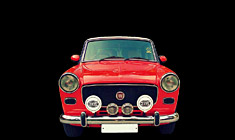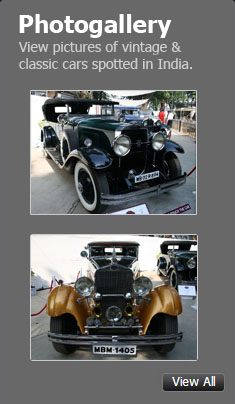News
Explained: Transport, Tanker, Reconnaissance Aircrafts of the IAF
This picture essay is on these machines that currently serve with the IAF and touches on some of them legends of yesteryears.
BHPian V.Narayan recently shared this with other enthusiasts.
Transport, Tanker, Reconnaissance Aircraft of the IAF
In each military arm there are those branches or regiments that attract the attention of the public while other equally important and hard working parts do not get to share the limelight in equal measure. With the IAF the fighter aircraft enjoy the public's eye and most readers on this forum would be familiar with names such as Sukhoi Su-30 MKI, Mirage 2000, MiG-21 and even yesterday's Gnat. The transport aircraft, the tankers and the most complex of them all Airborne Early Warning & Command (AEW&C) aircraft remain in the background.
This picture essay is on these machines that currently serve with the IAF and touches on some of them legends of yesteryears.
This is an essay for light reading with interesting factoids based on public information and not an aeronautical technical treatise. I have consciously kept away from jargon and abbreviations which would take away the joy of reading for the non-aviation reader.
India has a fleet of ~200 transport aircraft. Not a bad number but we don't have the right mix by lift capacity or vintage. This is a problem that plagues the IAF's procurement in most areas. Our lifting capacity peaked in circa 1990 and has very slowly declined thereafter from the mid-1990s with the withdrawal of the Antonov An-12's and the collapse of the Soviet Union.
HEAVY LIFTERS
These are the strategic work horses and long range heavy lifters. What is heavy lift has changed over the years from meaning a lifting capacity of 21 troops or 2 tonnes in 1942 to a lifting capacity of 150 troops or 77 tonnes today. The role of a heavy lifter, especially today is to rapidly move troops, light armour and equipment to the point where it is needed either to address an issue or serve as a deterrent and to do it quickly. The key characteristic is speed of response. So other than a meaningful payload the machine needs range and the ability to land on a short rough forward air strip. This includes the competence to find the air strip in the first place in an environment where radio navigation may not be desirable and do it at night. It also includes the capacity to be independent of ground support to turn the aircraft around and depart.
The IAF's strategic heavy lift capability unfortunately has not changed much between 1991 and today. Then we had ~40 IL-76 Russian aircraft and to day we have a mixed bag of 11 Boeing C-17's and 17 IL-76's. The theoretical lift capacity of the fleet was 1600 tonnes in 1991 and it is 1527 tonnes today.
Ideally our need is for ~45 heavy lifters to allow for adequate rapid lift to forward areas such as Ladakh, Arunachal etc plus cater to attrition, maintenance cycles, reserves. We only have about 60% of that number and over half the fleet is long in the tooth.
Boeing C-17 Globemaster
World's nos 1 military strategic heavy lift aircraft

The world's largest, most reliable, long range military heavy lift aircraft. Period. We would have liked to have 25 to 30 in our fleet but landed with 11 {out first order} because despite Boeing asking us if we want more as they were planning to close down the assembly line our Ministry of Defence took so long to answer that by then Boeing had shut down the line and we lost the opportunity for another generation to augment our depleting heavy lift assets. The Russian An-124 is larger and carries more payload but is basically a civil cargo lifter and does not have the C-17's ability to take off from hot and high air strips, descend steeply into or climb steeply out of restricted airstrips, reverse on the ground etc.

This is a 265 tonne machine that carries a 77 tonne payload. With a 71 tonne payload it goes 5200 kms with reserves and land at the destination in 1050 metres. Lightly loaded the aircraft can take off in 900 metres quite remarkable for a machine this size. The aircraft is powered by 4 Pratt & Whitney 18,360 kgf turbofans with reverse thrusters that allow it to self-reverse at remote air strips - a most useful facility in war. She carries 108 tonnes of fuel in the wings. The C-17 is much bigger than an Airbus A321 and slightly smaller than a A330.

The cargo compartment is 88 feet long by 18 feet wide by 12 feet 4 inches high. The cargo floor has rollers with holds for palletized cargo. The floor can be flipped to provide a flat floor suitable for tracked & wheeled vehicles. Cargo is loaded through a large aft ramp that accommodates rolling stock, such as a main battle tank or a tracked 155mm artillery gun or a Pinaka rocket launcher 8x8 or palletized cargo. Typical payloads could be 134 to 175 troops or 1 main battle tank plus cargo or 3 infantry combat vehicles plus cargo, or 3 Apache AH-64 attack helicopters and such like.

Photo depicting the large externally blown flaps* running over 2/3rds of the large 3800 sq feet wing. Plus, it has full span leading edge slats** all of this combine to give the C-17 its high sink rate and short take-off and landing ability. Unusually the aircraft can activate the reverse thrusters in flight to slow it down rapidly and help it make a steep descent much needed when landing in the Himalayas.
Length 53m; Span 52m; MTOW 265t; Payload 77t; Cargo hold volume 535 m3; Take off run 2600m; Cruise 830 kmph Sweep 25 degrees; Fuel 108t; Range 4400 kms
MTOW - maximum takeoff weight; m - metres; t - tonnes; m3 - cubic metres
* these increase the wings lifting ability especially at slow speeds by 2X and more. **these reduce take-off and landing speeds, enable the wing to fly at higher angles of attack and improve control low and slow.
Ilyushin IL-76MD
IAF's first heavy lifter

Before the C-17, above, the Ilyushin IL-76 was the multi-purpose military heavy lifter of choice with 20 Air Forces around the world and over {hold your breath} 120 air cargo operators over the past 45 years. Its ruggedness and reliability married to a fully adequate payload, range and ability to operate from rough airstrips makes it the preferred choice of aircraft even today. During the Afghan occupation by USSR, {1980-89} the IL-76 flew almost 90% of the Russian Army & its equipment into that country and several aircraft got shot at by cannon fire, machine gun fire and shoulder launched heat seeking missiles. In this trial by fire the IL-76's ruggedness shone through. So much so that when the Americans and NATO launched their invasion of Afghanistan some NATO countries including Canada insisted on using only IL-76s to ferry their troops of occupation! It is one of the few military freighters to be equipped, in the wheel well fairings, with flare dispensers. and till recently the IAF fleet carried a twin 23mm cannon mounting in the rear beneath the tail. In Afghanistan the Soviets used the 23mm's to spary the ground behind the aircraft while taking off to deter wanna be Stinger missile shooters.
The IAF acquired 40 in the 1980s. About 17 are in service today sadly long in the tooth.
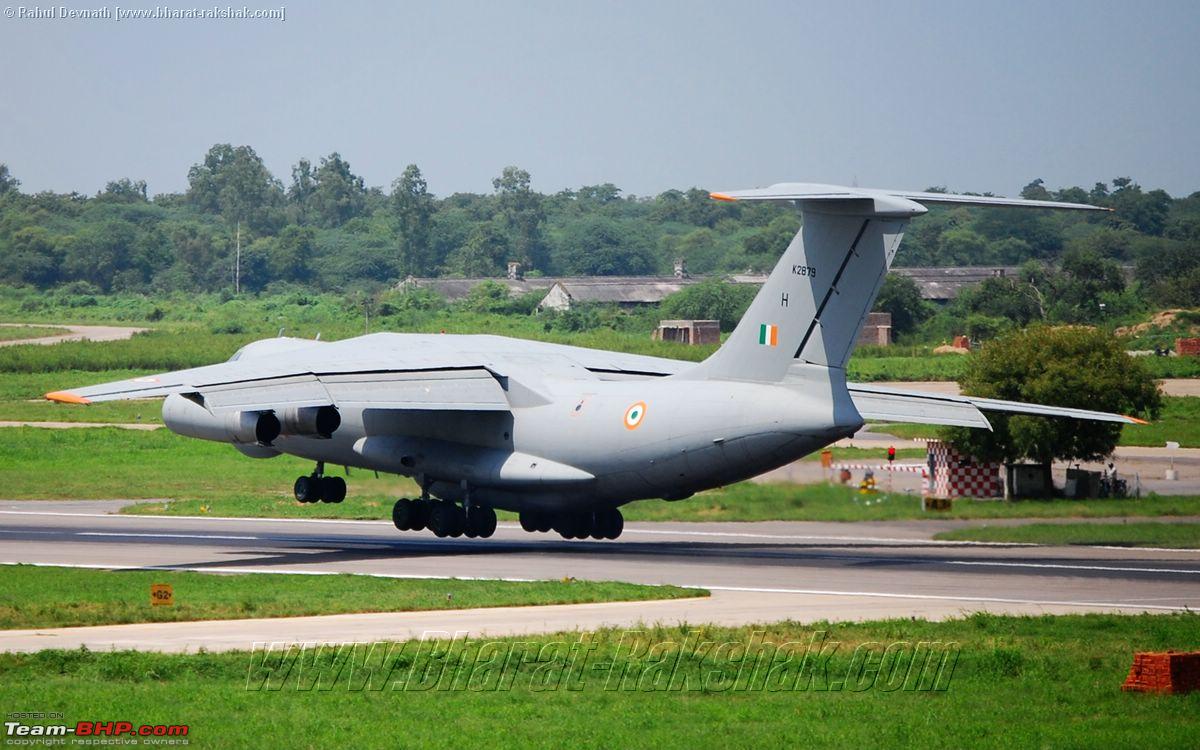
The IL-76 follows the now standard configuration for military freighters - shoulder mounted wings, T-tail and 4 engines. Those 51 metre wings are equipped with triple slotted flaps over 3/4ths of the wing, full span leading edge slats, spoilers and air brakes and four engines blasting exhaust into the flaps at take-off and landing. These features married to that massive 36-wheel undercarriage gives it great rough field capability needed in forward areas. It is powered by 4 Soloviev D-30KP turbofans developing 12,000 kgf of thrust each that give it a cruise speed of 750 kmph at 39,000 feet and a range of 4700 kms with a 40-tonne payload.
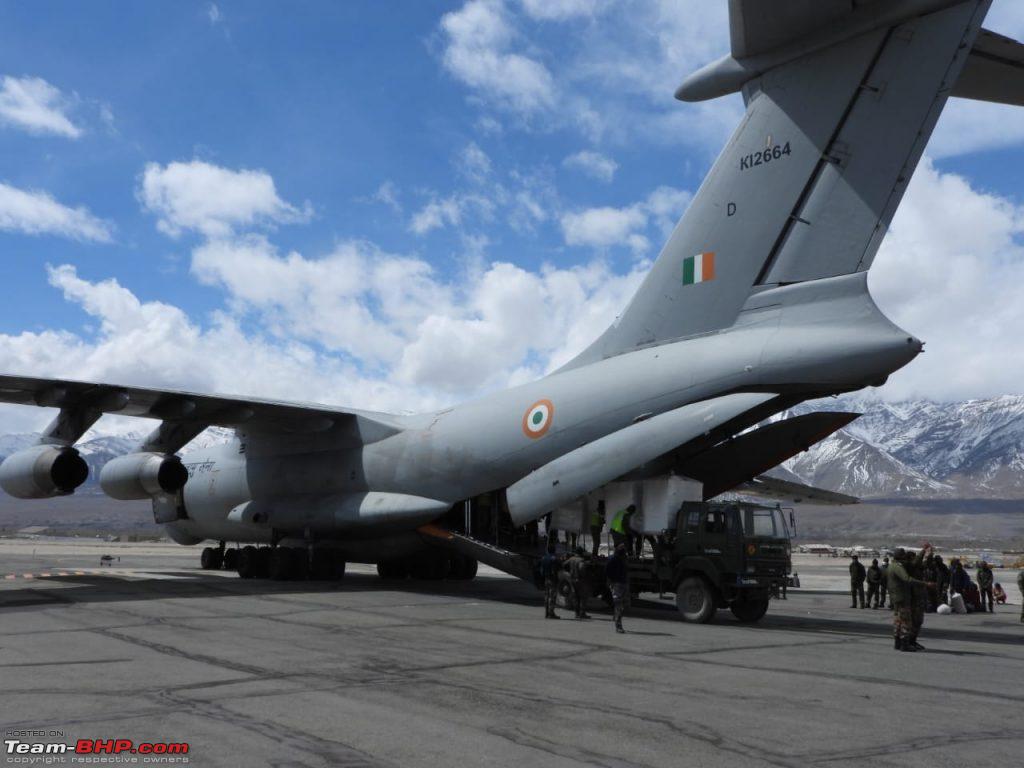
The IL-76's piece de resistance is its 80 foot long, 11 feet wide and 11 feet high cargo hold that can carry up to 47 tonnes. The aircraft is equipped with winches within the hold to pull in or haul out cargo on its own without need for ground equipment a very useful feature on a forward airstrip. Typical payload can be 126 troops or one main battle tank or 3 infantry combat vehicles or 5 155mm artillery field guns.
Length 47m; Span 51m; MTOW 190t; Payload 47t; Cargo hold volume 235 m3; Take off run 1700m; Cruise 750 kmph; Sweep 25 degrees Fuel 84t; Range 4700 kms
MEDIUM LIFTERS
Lockheed C-130J Hercules
The world's most prolific military transporter; in production for 70 years
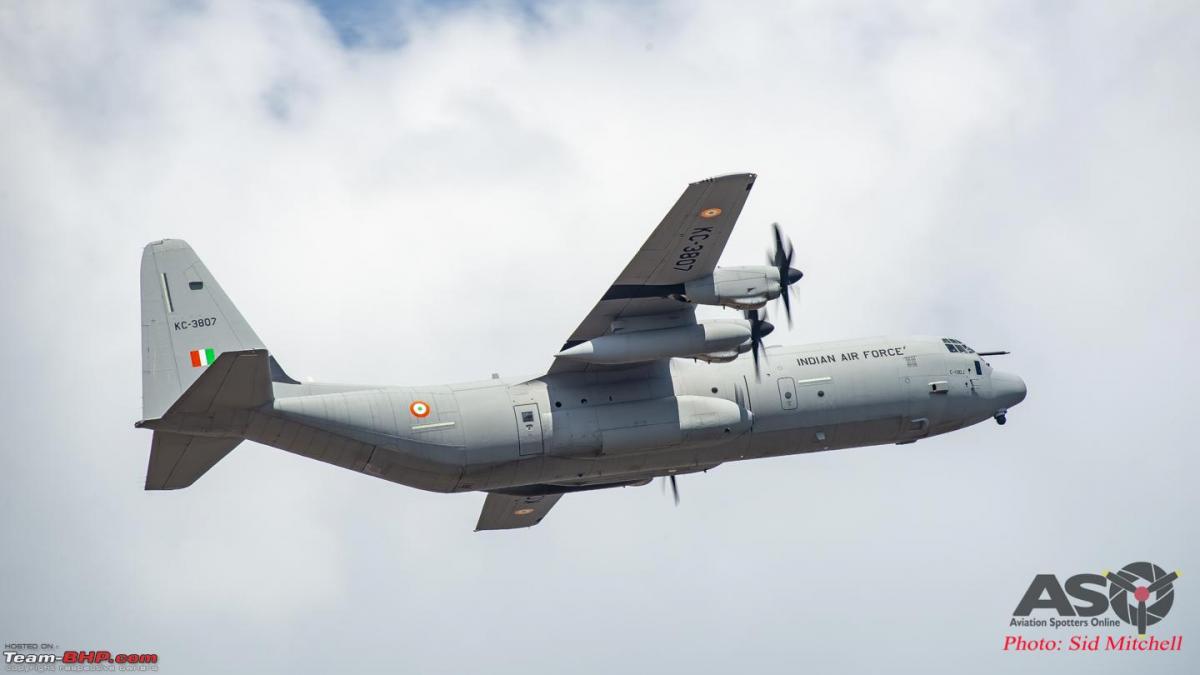
The latest modernized variant of the military aircraft with the longest running production in history. When our Antonov An-12's retired in the 1990s we had a gaping hole in our military air transport capabilities in the 20-tonne class which normally should have formed the backbone of the fleet. That's where the Lockheed C-130J-30 fits in. The Americans have a comprehensive manner of nomenclature for their military aircraft. The 'C' means cargo aircraft; the 130 is the running serial number Americans allot to a design, so this was the 130th support aircraft design; J stands for Mark starting with A and going forward alphabetically; the '-30' stands for extended fuselage. We acquired 12. I wish we had acquired 36 which would have tallied better with our needs. But at $200million a machine these are not cheap.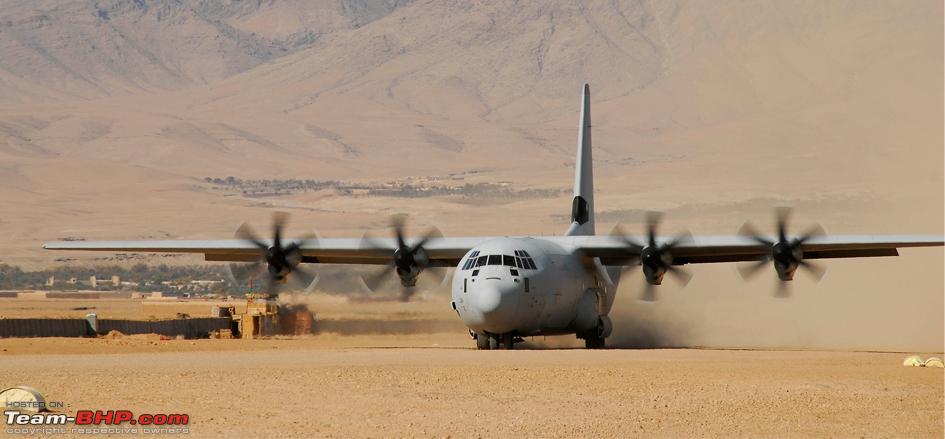
The C-130 was the very first military transport aircraft to incorporate all the features needed to make an ideal military lifter - a folding rear ramp; a high single tail; landing gear fitted into fairings under the fuselage such that the cargo floor is at truck bed height; cockpit transparencies that allow the pilots to look straight down, winches & rollers in the bay and a large shoulder mounted high lift wing to allow for a STOL capability and engines mounted high to reduce ingestion of mud and dust at rough forward airfields. These aircraft also have a classified special operations capability.
Length 34m; Wingspan 40m; MTOW 70t; Powerplant 4 x 5637 ehp turboprops; Cruise speed 644 kmph; Range ~5200 kms with normal payload of 16t; Cabin length 19m; Payload 16t normal, 20t full load; Take off run 930m
ehp = effective horsepower i.e. hp going down the shaft plus the energy in the jet exhaust of a turboprop.
Video on the C-130 in IAF service
Antonov An-32
IAF's 'hot and high' work horse

The work horse of the IAF transport fleet. Over 100 in service. They are now 30 to 40 years old and urgently in need of replacement. The aircraft equivalent of a go anywhere 4WD vehicle. Designed by the Soviets to an IAF specification for a medium lifter with excellent hot and high capability as well as reasonable STOL performance and the ability to operate from rough forward airstrips. The Antonov bureau took the Antonov An-26 airframe, fitted it with the largest engines they could fit and that raw power gives the An-32 its real world military performance and butch looks. As has often happened with IAF procurement, back in c.1980 we turned down the Soviet offer to license build the aircraft and the engines in India as we lacked a cohesive vision of developing an aeronautical ecosystem. Had we gone down that path we could have been flying greatly upgraded indigenous versions today instead of license assembling C-295s described below.

This aircraft can takeoff from 50 degree C temperatures of a desert to the airstrip of Daulat Beg Oldie at an altitude of 16,700 feet.
Length 24m; Wingspan 29m; MTOW 27t; Powerplant 2 x 5112 ehp turboprops; Cruise speed 470 kmph; Range ~1300 kms with a full payload; Cabin length 16m; Payload Volume 66m3; Payload 6.7t
Airbus C-295
Our tactical lifter to be

With both the An-32 {above} and the Avro HS748 {below} getting very long in the tooth the IAF finally selected the Airbus C-295 as its new tactical lifter with an order for 56 and a plan for a further 15 for the Navy and the Coastguard. Fortunately, 4 decades late, we are displaying strategic vision by having Tata set up a new plant to build these aircraft and hopefully that plant will become a private sector alternative to HAL's monopoly and give the IAF an alternative supplier for this and other aircraft in the future. The C-295's capability, as with all great aircraft, is in its wing design and engines that can develop full power at, IIRC 37 degrees C.
Length 25m; Wingspan 25m; MTOW 21t, with 23t overload; Powerplant 2 x 2644 ehp turboprops with emergency power of 2919 ehp; Cruise speed 482 kmph; Range ~1500kms with a full payload; Payload 7t or 73 troops; Takeoff run 950m
UTILITY TRANSPORTS
Avro HS.748
The odd ball in our inventory

The aircraft that isn't a military lifter, can't carry much, can barely fit a jeep let alone a field gun, does not possess a rear loading ramp, has limited cargo volume and that struggles with hot and high take-offs. This machine which BTW I love, has no place in our inventory except that a ruthless and overbearing defense minister of yesteryears took a fancy to it and ordered it from Avro in 1960 without the IAF being aware or consulted or ever having test flown the machine. Such was the way the MoD was run in the late 1950s and early 1960s till the 1962 Indo China war put paid to this sort of conduct. We assembled about 89 of these at HAL of which 72 were destined for the IAF. 57 of those now all over 35 years of age are still in service. Mind you it is a decent passenger commuter airliner just that it isn't a military freighter. Think of taking a Maruti Ecco and say now you will be used as a construction site dumper. Sadly, the IAF soldiers on with a wholly inadequate and inappropriate asset.
Length 20m; Span 32m; MTOW 19t; Payload 5t; Take off run 4100 feet; Cruise 450 kmph; Fuel 5t; Range 1200 kms at full payload
Dornier Do 228
Utility maid of all work

One of the best acquisition decisions we took. An outstanding machine with a strong power to weight ratio, low drag, a super critical* wing and fowler flaps**. The latter two generate large lift at slow speeds giving it a STOL capability and ability to patrol low and slow like needed by the Navy and the Coast Guard. It is the flying Maruti Gypsy of the Indian Armed forces. Used by the IAF as a utility light transporter where a larger more expensive machine is not needed. Its competent hot and high capability married to its STOL abilities make it a decent go anywhere machine. And its solid German engineering shows out in its despatch reliability.
Length 17m; Wingspan 17m; MTOW 6.5t; Payload 2.2t; Cruise speed 430 kmph; Stall speed 150 kmph; Range 1100 kms with a full payload; Take off run 1500 feet
*A super critical wing design delays the onset of the wing drag wave. Net net it creates less drag for a given lift.
** Fowler flaps are high-lift devices situated at the trailing edge of the aircraft wings. When deployed, they slide backward and downwards, increasing the wing's surface area and camber, producing a large amount of lift. It’s like having the power to change the shape of the wing. Most airliner we fly in today use some variant of a fowler flap
AIRBORNE EARLY WARNING
Beriev A-50
Long range early warning and air direction control

The mission personnel of the 15-man crew derive data from the large Israeli EL/W-2090 surveillance radar with its antenna in an over-fuselage rotodome, which has a diameter of about 9 metres. Detection range is 650 kilometres (400 mi) for air targets and 300 kilometres (190 mi) for ground targets. The EL/W-2090 uses the active electronically scanned array (AESA)*, an active phased array radar. This radar has a electronically steered beam making a physically rotating rotodome unnecessary. AESA radars operate on a pseudo-random set of frequencies and also have very short scanning rates, which makes them difficult to detect and jam.
*AESA radars scan electronically and not through a physically rotating radome. In short they are more precise, more resistant to jamming and can detect much smaller targets amidst the clutter of the land or sea surface.
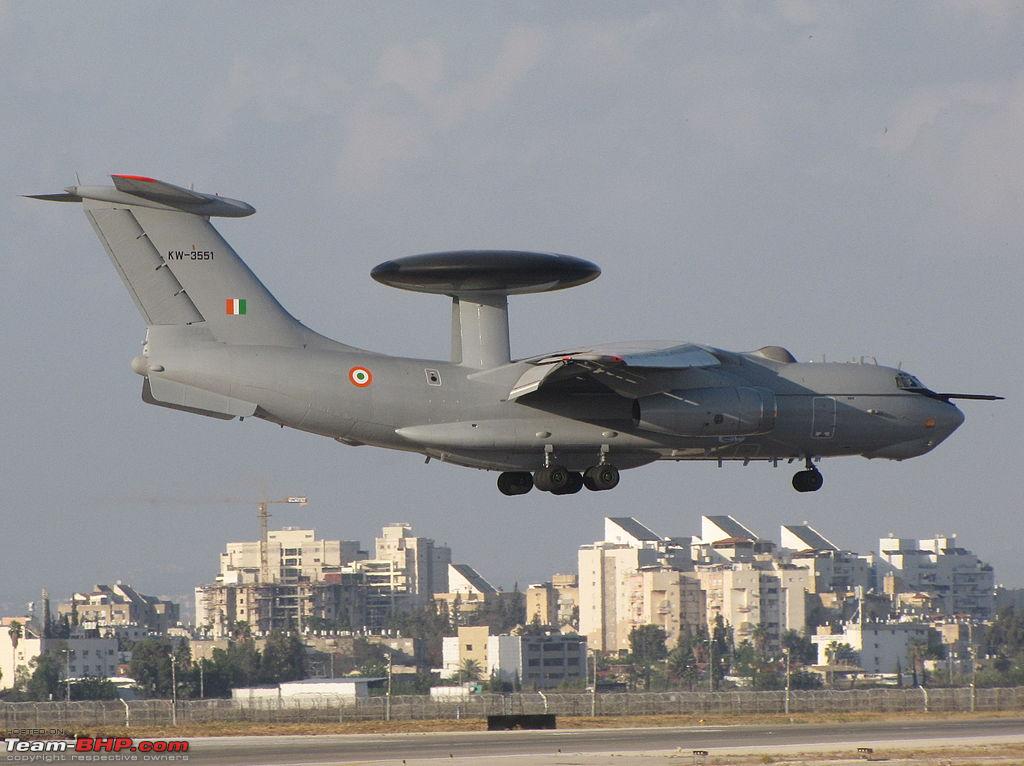
The A-50 can simultaneously control several fighter aircraft for either air-to-air intercept or air-to-ground attack missions. The A-50 can fly four hours at 1,000 kilometres (620 mi) from its base at a maximum takeoff weight of 190 metric tons (420,000 lb). The aircraft can be refuelled by Il-78MKI tankers described below to help it stay in the air much longer.
Length 50m; Wingspan 50m; MTOW 190 tonnes; Engines 4 x 16,000kgf turbofans; Top speed 900 kmph; Range 7500 kms; Patrol 4 hours at 1000 kms radius
Continue reading BHPian V.Narayan's insights on the Indian Aviation transport, tanker & Reconnaissance aircrafts of the IAF for more information.















.jpg)
